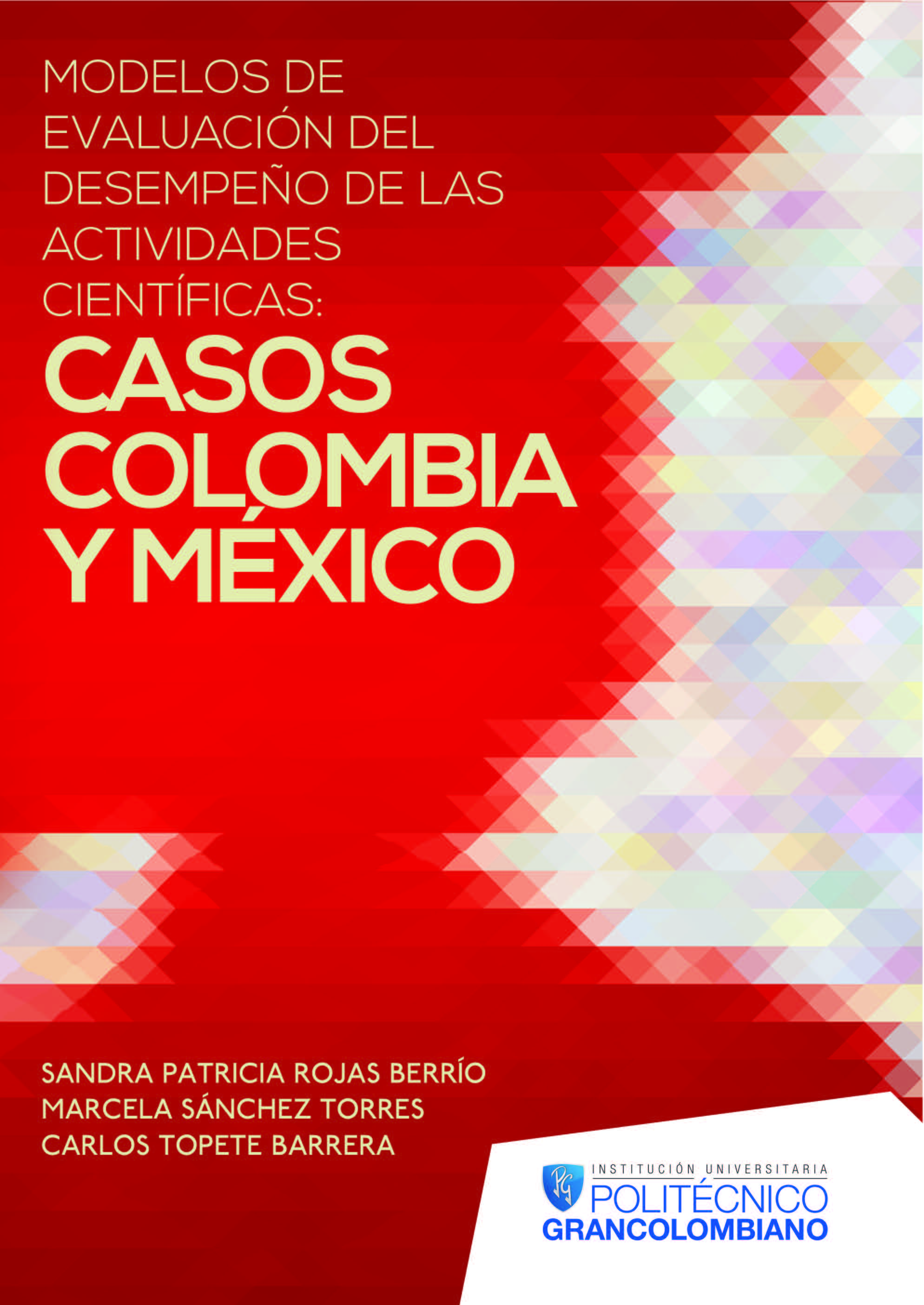Resumen
Este capítulo presenta los modelos de evaluación de desempeño de actividades científicas para Colombia y México. Con el fin de ubicarlo en un contexto, en primera instancia, se presentan para cada caso las cifras de Ciencia, Tecnología e Innovación (CTI), orientado por la pregunta ¿Cuáles son los indicadores de entrada y salida del Sistema de CTI de cada país?
Referencias
Díaz Barriga, A. (1996). Los Programas de Evaluación (Estímulos al rendimiento académico) en la Comunidad de Investigadores. Un Estudio en la UNAM. Revista Mexicana de Investigación Educativa, 1(2), 408–423.
Didou-Aupetit, S., & Etienne, G. (2010). El Sistema Nacional de Investigadores, Veinticinco años después (Primera ed., pp. 1–151). México: ANUlES.
Diem, A., & Wolter, S. C. (2012). The Use of Bibliometrics to Measure Research Performance in Education Sciences. Research in Higher Education, 54(1), 86–114. doi:10.1007/s11162-012-9264-5
Docampo, D. (2010). Erratum to: On using the Shanghai ranking to assess the research performance of university systems. Scientometrics, 86(1), 237–237. doi:10.1007/s11192-010-0315-4
Duke, J., & Moss, C. (2009). Re-visiting scholarly community engagement in the contemporary research assessment environments of Australasian universities. Contemporaty Nurse, 32(1), 30–41.
Eisenmann, L. (2004). Integrating Disciplinary Perspectives into Higher Education Research: The Example of History. The Journal of Higher Education, 75(1), 7–22. doi:10.2307/3838686
Erfanmanesh, A., Didegah, F., & Omidvar, S. (2010). Research productivity and impact of Library and Information Science in the Web of Science, 15(3), 85–95.
Fairweather, J. S. (2002). The Mythologies of Faculty Productivity: Implications for Institutional Policy and Decision Making. The Journal of Higher Education, 73(1), 26–48. doi:10.2307/1558446
FCCT. (2013). ¿Qué es el Foro Consultivo? Retrieved August 04, 2013, from http://www.foroconsultivo.org.mx/home/index.php/about-foro/que-es-el-fccyt
Feld, A. (2010). Planificar, Gestionar, Investigar. Debates y conflictos en la creación del CONACYT y la SECONACYT (1966-1969). Ea, 2, 1–43.
Fishman, B., Marx, R. W., Blumenfeld, P., Krajcik, J., & Soloway, E. (2004). Creating a Framework for Research on Systemic Technology Innovations. The Journal of the Learning Sciences, 13(1), 43–76. doi:10.2307/1466932
Flores, M., Al-Ashaab, A., & Magyar, A. (2009). A balanced scorecard for open innovation: Measuring the impact of industry-university collaboration. (C.-M. L.M., P. I., & A. H., Eds.) IFIP Advances in Information and Communication Technology. Research and Networking, Processes and IT, CEMEX Global Center for Technology and Innovation, CEMEX Research Group AG, Römerstrasse 13, Brügg CH 2555, Switzerland. Retrieved from http://www.scopus.com/inward/record.url?eid=2-s2.0-70350238141&partnerID=40&md5=1846480daba7314b43d1954932ee969f
Fog, L. (2012, April 15). Colciencias : ¿Una pesadilla sin fin? El Espectador, pp. 1–4. Bogotá D.C.
Ford, J. B., & Merchant, A. (2008). A Ten-Year Retrospective of Advertising Research Productivity, 1997-2006. Journal of Advertising, 37(3), 69–94. doi:10.2753/JOA0091-3367370306
Fox, M. F., & Mohapatra, S. (2007). Social-Organizational Characteristics of Work and Publication Productivity among Academic Scientists in Doctoral-Granting Departments. The Journal of Higher Education, 78(5), 542–571. doi:10.2307/4501228
Frey, B. S. (2007). Evaluations, evaluations evaluitis . Evaluierungen, Evaluierungen ... Evaluitis, 8(3), 207–220. Retrieved from http://www.scopus.com/inward/record.url?eid=2-s2.0-34547260160&partnerID=40&md5=4cab967cce04cf4b4e5dc2ebba0fbbd5
García, J. a., Rodriguez-Sánchez, R., Fdez-Valdivia, J., Robinson-García, N., & Torres- Salinas, D. (2012). Benchmarking research performance at the university level with information theoretic measures. Scientometrics. doi:10.1007/s11192-012-0854-y
García-Aracil, A., & De Lucio, I. F. (2008). Industry - University interactions in a peripheral European region: An empirical study of Valencian firms. Regional Studies, 42(2), 215–227.
García-Aracil, A., Gutiérrez Gracia, A., & Pérez-Marín, M. (2006). Analysis of the evaluation process of the research performance : An empirical case. Scientometrics, 67(2), 213–230. doi:10.1556/Scient.67.2006.2.5
García-Aracil, A., & Palomares-Montero, D. (2010). Examining benchmark indicator systems for the evaluation of higher education institutions. Higher Education, 60(2), 217–234. doi:10.2307/40784178
Giraldo, S. (2012, July). Colciencias...y ¿ahora qué? Noticias de La Antropología, (July 2012), 1.
Goldstein, H. (2012). Estimating research performance by using research grant award gradings. Retrieved from http://www.sinab.unal.edu.co:2065/stable/23013394?&-Search=yes&searchText=“Research+Assessment”&searchText=team&searchText=Research&searchText=“Research+Productivity”&searchText=group&search-Text=“Research+Performance”&searchText=University&list=hide&searchUri=/action/doAdvancedSearch?q0=%22Research+Assessment%22&f0=ti&c1=OR&q1=%22Research+Performance%22&f1=ti&c2=OR&q2=%22Research+Productivity%22&-f2=ti&c3=AND&q3=University%2
Gómez, I., Bordons, M., Fernández, M. T., & Morillo, F. (2008). Structure and researchperformance of Spanish universities. Scientometrics, 79(1), 131–146. doi:10.1007/s11192-009-0408-0
Gómez-Campo, V. M. (2012). Entrevista para Informe de Estancia Sabática. In C. Topete-Barrera & S. P. Rojas-Berrio (Eds.), (p. 3). Bogotá: Universidad de São Paulo.
Grossman, J. H., Reid, P. P., & Morgan, R. P. (2001). Contributions of Academic Research to Industrial Performance in Five Industry Sectors. Journal of Technology Transfer, 26, 143–152.
Gu, J., Lin, Y., Vogel, D., & Tian, W. (2010). What are the major impact factors on research performance of young doctorate holders in science in China: an USTC survey. Higher Education, 62(4), 483–502. doi:10.1007/s10734-010-9400-0
Guan, J., & Gao, X. (2008). Comparison and evaluation of Chinese research performance in the field of bioinformatics. Scientometrics, 75(2), 357–379. doi:10.1007/s11192-007-1871-0
Guan, J., & Ma, N. (2004). A comparative study of research performance. Scientometrics, 61(3), 339–359.
Hackett, E. J. (2005). Essential Tensions: Identity, Control, and Risk in Research. Social Studies of Science, 35(5), 787–826. doi:10.2307/25046671
Hansson, F., & Mønsted, M. (2008). Research Leadership as Entrepreneurial Organizing for Research. Higher Education, 55(6), 651–670. doi:10.2307/29735213
Harman, G. (2002). Australian university-industry research links: Researcher involvement, outputs, personal benefits and “withholding” behaviour. Prometheus, 20(2), 143–158. Retrieved from http://www.scopus.com/inward/record.url?eid=2-s2.0-0036056967&partnerID=40&md5=944ad991554170a5e82dd271637521e1
Harvey, J., Community, N., & Studies, C. (2002). The determinants of research group performance: towards mode 2?*, (September), 22–28.
Harvey, J., Pettigrew, A., & Ferlie, E. (2002). the Determinants of Research Group Performance: Towards Mode 2?*. Journal of Management Studies, 39(6), 747–774. doi:10.1111/1467-6486.00310
Hayashi, T., & Tomizawa, H. (2006). Restructuring the Japanese national research system. Scientometrics, 68(2), 241–264.
Hesli, V. L., & Lee, J. M. (2011). Faculty Research Productivity: Why Do Some of Our Colleagues Publish More than Others? PS: Political Science and Politics, 44(2), 393–408 CR – Copyright © 2011 American Polit. doi:10.2307/41319926
Hicks, D. (2009). Evolving Regimes of Multi-University Research Evaluation. Higher Education, 57(4), 393–404. doi:10.2307/40269131
Hickson, M., Bodon, J., & Turner, J. (2004). Research productivity in communication: An analysis, 1915–2001. Communication Quarterly, 52(4), 323–333. doi:10.1080/01463370409370203
Hodder, a. P. W., & Hodder, C. (2010). Research culture and New Zealand’s performance-based research fund: some insights from bibliographic compilations of research outputs. Scientometrics, 84(3), 887–901. doi:10.1007/s11192-010-0201-0
Horri, A. (2004). Bibliometric Overview of Library and Information Science Research Productivity in Iran. Journal of Education for Library and Information Science, 45(1), 15. doi:10.2307/40323918

Esta obra está bajo una licencia internacional Creative Commons Atribución-NoComercial-SinDerivadas 4.0.
Derechos de autor 2014 Institución Universitaria Politécnico Grancolombiano





